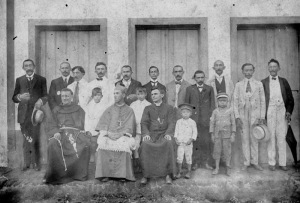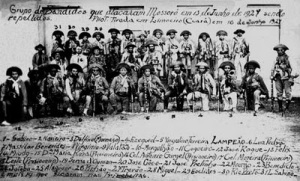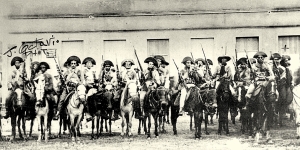Para os países que falam Inglês
http://www.1000dias.com
The cangaceiros recognized
themselves in a simple idea, revenge, the realization of which touched them
directly. They formed a warrior community whose social project (revenge is,
indeed, a social project) was absolutely negative and for the most
part completely personal. Each one had his revenge to carry out. It belonged to
her and related to a given person or, more generally, a given family. And he
intended to bring it to a good end, if he had not already done so. The entire
constituted order was opposed to her revenge. By carrying it out, the cangaceiro challenged
the entire society.
The cangaceiro did
not criticize the society in which she lived, but the goal she pursued made him
a rebel. The millenarians didn’t seek to avenge themselves or, more precisely,
the hour of vengeance did not belong to them, since it was up to God or a
supernatural being like king Dom Sebastião, but they criticized society. Thus,
it was almost inevitable that they would meet, as they did, in fact, in Canudos.
The state arranged to transform a spiritual community into a warrior community
and an individual in search of revenge into a social bandit.
Members of the
elite of a city in northeastern Brazil, during the visit of a high dignitary of
the Catholic church. The most prominent members of this select group were known
as “colonels” – http://tokdehistoria.wordpress.com
The insult
that the cangaceiro had to erase came both from an individual and
from the society that supported that individual, that was his accomplice. The
offense didn’t come from an isolated individual, from one’s likes — in those
days, settling such an insult would not have been a problem — but from a social
authority. It could be an insult from a “colonel” or someone in his circle,
which amounts to the same thing. The offense came from a fazendeiro who
was invested with both a social authority as a large property holder and a
political authority as a representative of the state in the region. The
vengeance of the cangaceiro, in fact, was a social vengeance.
Carrying it out didn’t just mean confronting an individual, but also the state
that stood behind him.
The cangaceiro made
his own justice toward and against the state, which always stood on the side of
the one who offended him. His inalienable and universal right as a free
individual came into conflict with the objective Right of the state, the
substance of which is revealed precisely in forcing the individual to alienate
her universal and immediate right to freedom.
“It is enough
that the I as free being am alive in the flesh, because it is prohibited to
degrade this living existence to the rank of pack animal. While I live, my mind
(which is concept and also freedom) and body are not separate; this constitutes
the existence of freedom, and it is in this that I experience it. It is a
sophistic concept without idea that makes the distinction according to which
the thing in itself, the mind — and even the idea of it — , is not struck when
the body is abused and when the existence of the person is subjugated to
another’s power.”[40]
Groups of
officers who hunted the bandits were known as “Volantes”. These men used
uniforms very similar clothes worn by bandits. The reason was the need to
protect the vegetation typical of dry region of Northeast Brazil, very thorny
and known as “Caatinga” – http://tokdehistoria.wordpress.com
By avenging
himself, the sertanejo realized his idea that all human beings were
equal in their humanity; he became effectively free, for himself and for
others. For him, this passage of the idea into concreteness corresponded to the
passage into clandestinity. He abandoned an abstract civil existence that
suddenly appeared for what it was, a servile existence. Thus, he became a cangaceiro.
Freedom is a
risk to take. Suffering an insult without reacting means submitting to the
power of another, falling into slavery. This corresponds to a person’s social
death, to which she can respond only with the master’s death.
Faced with an
essentially human reaction, the academics of our times, like Josué de Castro[41],
go so far as to even speak of a nutritional deficiency to explain the rebellion
of the cangaceiros or the millenarians, and talk of flight when they
should confront the state and the world. Who knows, maybe in referring to these
academics, one could have spoken of a chronic deficiency of the most elementary
intelligence of human practices.
The sertanejos possessed
this intelligence, recognizing themselves in the cangaceiros and
appreciating them as courageous human beings who preferred to put their lives
at stake than to die as slaves. The fact is that from one moment to the next
any sertanejo might have been forced to go into hiding for similar
reasons. These people were on the verge of slavery. Their existence as free
human beings ceaselessly threatened to collapse into submission, to fall or
return into slavery. They were always ones who lived and reacted in haste.
In June 1927,
Lampião attacks the town of Mossoró, in state of Rio Grande do Norte. After
this attack took place this photo in the city of Limoeiro, in the state of
Ceará. You can see some hostages – http://blogdomendesemendes.blogspot.com.br
The cangaceiro showed
through his actions that even the poor could become terrifying. Feared and
admired, a cruel hero and a bandit with a big heart, he quickly became a
mythical figure of the sertão.
In the cangaceiros’
heroic deeds, it is difficult to distinguish legend from reality. The
testimonies, the depositions, the poetry, the stories and the news articles
accumulated and contradicted each other. Reality itself, in which shameful
self-interest, betrayal and complicity, boldness and deceit were mixed, was not
only complex and contradictory, but already legendary. With the cangaceiros,
reality had been pierced by an idea. It belonged to an epic poem.
In the 19th century,
starting from Brazil’s independence, social banditry spread within the country,
reaching its peak at the proclamation of the Republic. Then it took on the
traits of modern cangaceirismo, which would reach its culmination in
Lampião in the 1930s.
Antônio
Silvino – http://tokdehistoria.wordpress.com
At the
beginning of the 20th century, two figures stood out: Antonio Silvino and
Sebastião (Sinhô) Pereira, with whom Virgulino Ferreira, the future Lampião,
took his first steps. Legend has presented them to us as especially good and
generous, in the style of social bandits like Robin Hood. Antonio Silvino was
captured in 1914 and sentenced to thirty years in prison. He was released after
twenty years. Sinhô Pereira withdrew into “public life”.
Virgulino
(Lampião) was born in 1897 in a small village in the province of Pernambuco,
where his father was a sharecropper on a small plot of land and also a mule
driver. One day, a detachment of the police, whose commander was linked to a
hostile family, slaughtered the old man and the mother.
Virgulino and
his brothers burned the mourning clothes in the barnyard and swore that from
that moment on they would no longer carry on mourning, but would rather carry
the gun. The sisters were entrusted to the youngest of them while the others
went into hiding. But finding themselves in an extremely precarious and
uncertain situation, after a few victorious conflicts with the military police,
they united with Sinhô Pereira’s cangaço.
In this photo
we see sitting Sinhô Pereira, the first head of the Lampião. Beside him is his
cousin Luiz Padre. These two famous outlaws fought many battles in the state of
Pernambuco – http://cariricangaco.blogspot.com.br
One of
Lampião’s first endeavors was the murder of “colonel” Gonzaga, director of the
Belmonte police in the state of Pernambuco. The man was killed with his entire
family, and even the goats and chickens in the barnyard were slaughtered. In
the end, Lampião removed the wedding ring from the corpse, put it on his finger
and didn’t take it off again until his final day.
When Sinhô
Pereira retired in 1922 (this could happen when one could count on the implicit
blessing of Father Cicero), Virgulino became the indisputable leader of the
band. Though he went on to become the most celebrated of the cangaceiros,
he would also be the last. Lampião wrote the final chapter of a history.
His nickname,
Lampião (lamp, lantern), came to him from one of his early battles. In the
course of a nocturnal ambush, he had taken to firing so quickly that it lit up
the night.
For nearly
twenty years, throughout the sertão, Lampião would wander from one
province to another over an immense landscape, appearing in an unpredictable
manner, scrambling his trails, always turning conflicts with the police to his
own advantage.
In this photo
we see the left Lampião and beside his brother Antônio –
http://cariricangaco.blogspot.com.br
“Let’s leave
civilians in peace. Against police and traitors: FIRE!”
The blows were
frequently struck by small groups commanded by the best men, while the leader
controlled everything. Sometimes the entire band took part in genuine war
expeditions. Lampião studied routes, sought to discover where there were
concentrations of money, followed the movements of the “flying squads”. He was
considered a “modern” bandit and used strategy and tactics most skillfully.
The band
stayed hidden for long periods in a safe place, a forest, an inaccessible
mountain chain, a desert oasis or the fazenda of a friend. The people
only moved in small groups to resupply ammunition, a very difficult enterprise,
to deliver messages demanding money and to buy food and other things. They
moved in a limited radius, just a dozen people with a guide, if need be; the
round lasted a week at the longest. At times, if the situation became too hot,
the band literally disappeared without leaving a trace, deliberately spreading
news and signals that confused the trails and making the police and beaters go
crazy. Then the cangaceiros rested and recovered from the fatigue of
their latest endeavors, preparing the next ones with high spirits.[42]
Lampião and
his band on horses. Note that one of the bandits uses a military bugle –
http://blogdomendesemendes.blogspot.com.br
Expeditions
lasted several months and could cover several northeastern provinces. Lampião
extorted money from the rich property owners, villages and sometimes cities of
a certain significance. He presented himself with his band, receiving the money
collected from the rich, merchants and property owners directly from the local
authorities. In some cases, he visited the school while the men sat in the
plaza of the church, then usually everything ended with a banquet followed by
dancing. The feast started with great binges of overflowing glasses of a brandy
called “a testarda” (“the stubborn woman”). Poetic challenges were launched
where the best bards confronted each other, while encounters came together and
dissolved… In the night, the troop took off singing their story to the tune of
“Mulher Rendeira”.
Olé, mulher
rendeira
Olé, mulher renda
Tu me ensina a fazer renda,
Eu te ensino a namorar!
Sometimes
things went badly. For example, during the attack on Inharéma (sic) in Paraíba.
The cangaceiros did not succeed in taking the center of the town.
That time, mad with rage, they retreated, destroying, looting and burning
everything that they found in their path.
“Upon returning to the state of
Pernambuco at the end of 1925, Lampião occupied the city of Custódia, but in
the most peaceful manner in the world. The bandits spent the day passing
through the streets. Everyone paid for his purchases. All around the area
sentries kept watch. Lampião extorted a few rich bastards, bought provisions,
medicine and ammunition. The tailor made clothing for him, finishing it the
same day, as promised, and was paid handsomely for it. Lampião sent a telegram
to the state’s governor, telling of all the colors, but he didn’t pay for this
on the pretext that the telegraph was a ‘public’ service. The police
detachment, having disappeared at the first alarm, gave no signs of life.”
Continuaremos na próxima semana.
Extraído
do blog: "Tok de História" do historiógrafo e pesquisador do cangaço
Rostand Medeiros
http://tokdehistoria.wordpress.com/2012/09/22/cangaco-millenarian-rebels-prophets-and-outlaws/















